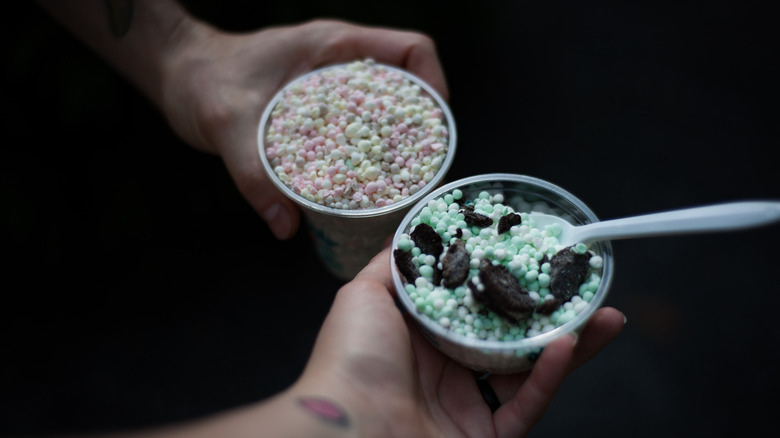How Dippin' Dots Are Really Made
A colorful treat found from amusement park stands to ball park ice cream vendors (though not most grocery stores), Dippin' Dots are a pretty cool twist on the same old scoop. These frozen little spheres, no bigger than the size of BBs, come in a wide variety of flavors ranging from birthday cake to brownie batter — classic flavors of ice cream without any of the dripping mess. From being found across thousands of stadiums and theme parks (according to the Dippin' Dots company website) to even a bizarre feud with former White House Press Secretary Sean Spicer on Twitter (via NPR), these little dots of creamy cold delights have had quite an interesting life.
As you sit in the hot summer sun in a packed stadium, polishing your plastic spoon clean of Cookies and Cream Dots, you may wonder: Just how do these things get made anyway? How can you make ice cream into something so small? What keeps them from melting back into the natural state of ice cream as a sticky puddle? The answer lies within a unique, scientific twist on the old freezer. Keep your spoons ready, and just be sure to not get frostbite.
The ice cream of the future
Just as the United States can lay claim to baseball and apple pie, we can also take pride in being the sole manufacturers of Dippin' Dots. Located in Paducah, Kentucky, the Dippin' Dots factory produces a whopping 28,000 gallons of Dippin' Dots per day (via Insider). While the ice cream process may seem to be the same as any other ice cream plant's procedures — for instance, mixing the flavors together — the coolest part (and that is meant quite literally) comes in the form of the special ingredient: liquid nitrogen.
Using liquid nitrogen to create ice cream was discovered by microbiologist Curt Jones in 1988 (via Dippin' Dots), who at the time was working as a researcher in cryogenics. The ice cream mixture is pumped into a machine known as a cryogenic processor, which contains an inner vat filled with steaming cold liquid nitrogen. As the ice cream drips into the machine, those little droplets instantly freeze solid. A word of caution, however: According to one worker at the factory (via a 2011 Food Network post on YouTube), it would be best not to eat the freshly frozen dots right out of the processor; "It'd be like sticking your tongue to a flagpole in the middle of wintertime."
Working with such a cold chemical can be a bit dangerous, such as an incident last July — a nitrogen explosion at the factory injured 10, though there were no fatalities (via USA Today).

